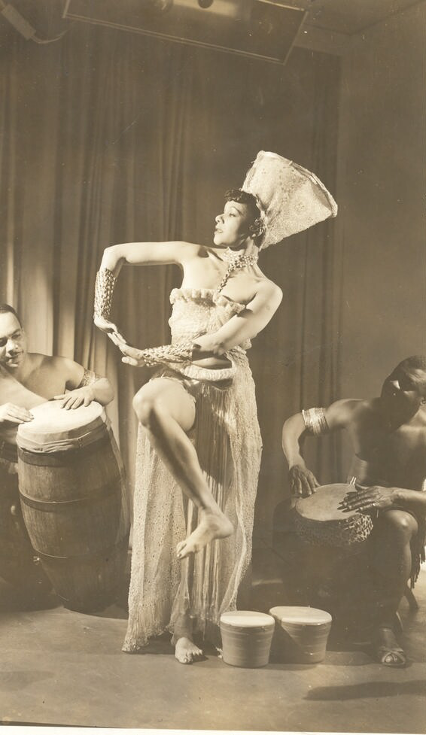Katherine Dunham
Lavinia Williams and Katherine Dunham

While Lavinia Williams was dancing with American Ballet Theatre, Katherine Dunham came to New York from Chicago, needing new dancers for her company. Lavinia took leave of de Mille’s Negro Unit of Ballet Theatre to dance with Dunham’s company and to perform in shows, such as Broadway musical Cabin in the Sky and the films Stormy Weather and Carnival of Rhythm. After dancing with the company for five and a half years, in 1945, Williams helped found the first Katherine Dunham School at Caravan Hall on 59th Street. She taught there for a year and then went to Europe with Noble Sissle’s revival of Shuffle Along for a USO tour. She performed one of the dancing roles that Josephine Baker had originated, later meeting Baker during a performance in Brussels.
Arthur Mitchell and Katherine Dunham (Katherine Dunham School of Dance)
Between seasons at New York City Ballet, Arthur Mitchell taught ballet at several schools, including the Katherine Dunham School. Katherine Dunham was a choreographer and founder of the Dunham technique, and she co-founded several companies before opening her own school, where Mitchell and others were guest teachers.
More about Katherine Dunham

Legendary dancer, choreographer and anthropologist Katherine Dunham was born on June 22, 1909 in Chicago to an African American father and a French Canadian mother. She sang in her local Methodist Church in Joliet, but if there hadn’t been a financial crisis at her church, she might never have sung anything but gospel songs. At age eight, she amazed and scandalized the elders of her church by doing a performance of decidedly non-religious songs at a cabaret party, in order to raise money. She never thought about a career in dance. Instead, she consented to her family’s wish that she become a teacher and followed her brother, Albert Dunham Jr., to the University of Chicago, where she became one of the first African American women to attend this university and earned bachelor, master’s and doctoral degrees in anthropology.
At the same time, she became a student of Ludmilla Speranzeva, formerly of the Moscow Theater, as well as Mark Turbyfill and Ruth Page. Following graduation, Dunham founded the Negro Dance Group. They performed at the Chicago Beaux Arts Theater in A Negro Rhapsody, dancing with the Chicago Opera Company. One of the performances was attended by Mrs. Alfred Rosenwald Stern, who was sufficiently impressed to arrange an invitation for Dunham to appear before the Rosenwald Foundation, which offered to finance any study contributing toward her dance career that she cared to name. Thus armed with foundation money, Dunham spent most of the next two years in the Caribbean studying all aspects of dance and the motivations behind dance. Although she traveled throughout the region, including Trinidad and Jamaica, it was in Haiti that she found special personal and artistic resonances. She wrote some scholarly essays during her trip and sold lighter magazine articles about the Caribbean under the name of K. Dunn.
Katherine Dunham revolutionized American dance in the 1930s by going to the roots of Black dance and rituals, transforming them into significant artistic choreography that speaks to all. She was a pioneer in the use of folk and ethnic choreography and one of the founders of the anthropological dance movement. She showed the world that African American heritage is beautiful. She completed groundbreaking work on Caribbean and Brazilian dance anthropology as a new academic discipline. She is credited for bringing these Caribbean and African influences to a European-dominated dance world.
She returned to the United States informed by new methods of movement and expression. She later created the Dunham Technique that transformed the world of dance.
In 1931, Miss Dunham met one of America’s most highly regarded theatrical designers, John Pratt, forming a powerful personal and creative team that lasted until his death in the 1986. They married in 1949 and adopted a daughter, Marie-Christine, an 18-month-old French child.
Dunham’s first school was in Chicago. In 1944 she rented Caravan Hall, Isadora Duncan’s studio in New York, and opened the K.D. School of Arts and Research. In 1945 she opened the famous Dunham School at 220 W 43rd Street in New York, where such artists as Marlon Brando and James Dean took classes.
Dunham’s big breakthrough to popular recognition took place after she moved to New York, where, in February 1939, she opened at the Windsor Theater in a program called Tropics and le Jazz Hot. It was supposed to be a one-night event, but demand was such that Dunham ended up doing 13 weeks and followed with her own Tropical Revue, which was a hit not only in the United States but also in Canada. She appeared at the Martin Beck Theatre in October of 1940 as Georgia Brown in Cabin in the Sky, which she also choreographed with George Balanchine.
She then founded the Katherine Dunham Dance Group, which later developed into the famous Katherine Dunham Company, devoted to African-American and Afro-Caribbean dance. Miss Dunham worked as a director in the Federal Theater Project, the government-sponsored relief program for artists that also nurtured such talents as Orson Welles and John Houseman. She co-directed and danced in Carib Song at the Adelphi Theater in New York in 1945 and was producer, director, and star of Bal Nègre at the Belasco Theater in New York in 1946.
Katherine Dunham is credited for developing one of the most important pedagogues for teaching dance that is still used throughout the world. Called the “Matriarch of Black Dance,” her groundbreaking repertoire combined innovative interpretations of Caribbean dances, traditional ballet, African rituals and African American rhythms to create the Dunham Technique. Her dance troupe in venues around the world performed many of her original works which include: Batucada, L’ag’ya, Shango, Veracruzana, Nanigo, Choros, Rite de Passage, Los Indios, and many more.
The Dunham Company toured for two decades, stirring audiences around the globe in 57 countries, with their dynamic and highly theatrical performances. Their first appearance in London was at the Prince of Wales Theatre in June 1948, in Caribbean Rhapsody, which was already a success in the United States and with which she was to tour Europe. It was the first time Europe had seen Black dance as an art form and also the first time that the special elements of American modern dance appeared outside America.
Her mastery of body movement was considered “phenomenal.” She was hailed for her smooth and fluent choreography and dominated a stage with what has been described as “an unmitigated radiant force providing beauty with a feminine touch full of variety and nuance.” The impact of Dunham’s show on the European post-war generation was fantastic. They had never been exposed to anything so culturally different and with such a power of total involvement. It was much more than the enthusiastic reaction to a brilliant theatrical experience. It was an exposure to a different culture and to a sense of magic and of beauty they knew nothing about.
Dunham also appeared in several films: Carnaval of Rhythms (1939), Star Spangled Rhythm (1942), Stormy Weather (1943), Casbah (1948), and more. She also choreographed, without appearing in, Pardon My Sarong (1942), Green Mansion (1958), and The Bible (1964). In 1962, Dunham and her company appeared in Bamboche, the three-act revue that first introduced to America the dancers of Morocco, who appeared with the consent of King Hassan II.
Dunham choreographed Aida in 1963 at the Met and continued to secure her place in artistic history by becoming the first African American to choreograph for the Metropolitan Opera. The last time the Dunham Company performed was in 1965 at the Apollo Theatre.
Katherine Dunham wrote several books: Journey to Accompong (1946), which describes her experiences with the Maroons; Las Danzas de Haiti (1947); Les Danses d’Haiti (1957); The Coffee Table Book of Dances of Haiti (1983); A Touch of Innocence (1959), an autobiography of her childhood; Island Possessed (1969); and Kasamance (1974), an African fable.
In 1965 Miss Dunham was invited to be an Artist in Residence at Southern Illinois University in Carbondale. While there, she directed a production of Faust and established a dance anthropology program at SIU in Edwardsville. In 1966, President Leopold Sedar Senghor invited Miss Dunham to come to Dakar for the famous “Festival des Arts Nègres” and to serve as director of the “Ballet National” and consultant for the year. The following year, Dunham created “The Performing Arts Training Center” and the Dunham Dynamic Museum in East St. Louis, Illinois. In 1972 she choreographed and directed Scott Joplin’s opera Treemonisha at Wolftrap; the production played in Washington, Atlanta, and St. Louis.
Most of Miss Dunham’s awards were for her contribution to the arts, but whenever she was engaged in conversation, she used the opportunity to teach and strategize to solve the social problems created by poverty and racism. She used her talent and insight to re-direct the energy of violent street gangs through the performing arts. Her efforts continue at her Dunham Centers in the St. Louis Metropolitan region. It is the only multi-disciplinary arts organization devoted to the study, appreciation, and celebration of diverse cultures.
Katherine Dunham was always a formidable advocate for racial equality, refusing to perform at segregated venues in the United States and using her performances to highlight discrimination. She was also politically active on both domestic and international rights issues and made national and international headlines by staging a hunger strike of 47 days in 1993 at the age of 82, to protest the US government’s repatriation policy for Haitian immigrants. She attempted to raise people’s consciousness in the United States about issues in Haiti.
By that time, she was considered a living, breathing, historical institution in and of herself. Throughout her distinguished career, Katherine Dunham earned numerous honorary doctorates, awards and honors. Among the list are: the Presidential Medal of Arts, a Kennedy Center Honor, the plaque d’Honneur Haitian-American Chamber of Commerce Award, French Legion of Honor, Southern Cross of Brazil, Grand Cross of Haiti, NAACP Lifetime Achievement Award, The Albert Schweitzer Music Award at Carnegie Hall, Lincoln Academy Laureate, and the Urban League’s Lifetime Achievement Award. Miss Dunham’s recognitions also include a star on the St. Louis Walk of Fame, inclusion in the book I Have a Dream, and the Women’s International Center’s Living Legacy Award. In her final years, she received an Honorary Degree in Fine Arts from Harvard, and Jacob’s Pillow gave a special tribute to Dunham for her 93rd birthday. In 2000, Dunham was named America’s irreplaceable dance treasure. The living Dunham tradition has persisted. She was a woman far ahead of her time. Her technique was “a way of life.”
Source:
Katherine Dunham Biography, Katherine Dunham Centers for Arts and Humanities

